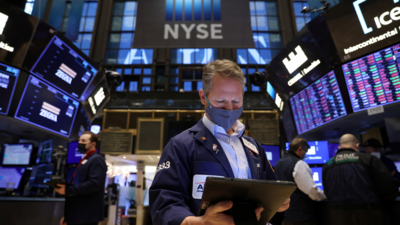
A trader in a face mask works on the trading floor at the New York Stock Exchange (Reuters)
NEW YORK: Wall Street is joining a worldwide recession for financial markets on Monday, amid concerns over how badly inflation and other forces will affect the economy.
The S&P 500 was down 1.8 percent in afternoon trading, following similar declines in Europe and Asia. Shares of oil producers helped lead after a 6 percent drop in the price of US crude on concerns that the latest coronavirus version could prompt factories, airplanes and drivers to burn less fuel.
Omicron may be the most feared force attacking the markets, but it’s not the only one. A proposed $2 trillion spending program by the US government dealt a potential death blow over the weekend when an influential senator said he could not support it. Markets are still absorbing last week’s significant move by the Federal Reserve to more quickly remove aid being thrown at the economy by rising inflation.
They all combined to pull the Dow Jones Industrial Average down 649 points, or 1.8 percent, at 34,716, as of 11:12 a.m. Eastern Time. The Nasdaq Composite fell 1.8 per cent, while Germany’s DAX fell 1.9 per cent and Japan’s Nikkei 225 fell 2.1 per cent.
“Omicron threatens to become a Grinch to rob Christmas,” Mizuho Bank’s Vishnu Varthan said in a report. The market “prefers security to nasty surprises.” With Covid-19 cases rising again, leaders of governments around the world are weighing the return of restrictions on businesses and social interactions at a time when many people feel sick from them.
The Dutch government on Sunday introduced a strict nationwide lockdown, while a UK official said on Monday it could not guarantee that new restrictions would not be announced this week. The Natural History Museum, one of London’s top attractions, said on Monday it was closing for a week due to a “lack of front-of-house staff”.
In the US, President Joe Biden will announce new steps he is taking on Tuesday, “issuing a dire warning about what winter will look like for Americans,” the White House press secretary said over the weekend. the press secretary said over the weekend.
Devon Energy fell 6.9 percent for one of the biggest losses in the S&P 500, creating a long list of losing oil stocks. Manufacturers of raw materials and finance companies were also down sharply amid Omicron concerns. Steelmaker Nucor lost 5.7 percent, and Synchronous Financial, which offers store-brand credit cards and other financial products, dropped 5.9 percent. Omicron’s eventual impact on the economy is unclear.
Besides weakening it by imposing restrictions on businesses, there is another fear that it could push inflation even higher. If it shuts down at ports, factories and other key points of the long global supply chain for customers, already entrenched operations could worsen.
Such troubles helped drive prices at the consumer level in November to 6.8 per cent from a year earlier, the sharpest inflation in nearly four decades.
But some economists argue that Omicron could have the opposite effect: If the variant leads to lockdowns or scares consumers to stay home, economic activity could slow, and with it, rising demand that has fueled supply chains. and raised consumer prices.
The worst-case scenario would be that the economy would collapse without providing relief from the already underlying inflation.
“The rapidly spreading omicron variant is likely to cause a temporary winter,” Oxford Economics economists Lydia Boussour and Gregory Dako wrote in a research report last week. He says the Federal Reserve may be faced with a “delicate” task of how to deal with an economic downturn that coincides with high inflation.
The yield on the two-year Treasury fell to 0.60 per cent from 0.66 per cent late Friday. It’s a sharp turnaround from its strong growth in recent months, built on expectations that the Fed may begin raising short-term interest rates in 2022 to tame inflation.
The yield on the 10-year Treasury fell to 1.38 per cent from 1.40 per cent late Friday.
Given higher inflation lasting longer than expected, the Fed last week targeted an earlier end to its program to buy billions of dollars worth of bonds each month, meant to keep long-term interest rates low. Several of its members also said they expect the Fed to raise short-term rates, a move that would be three times more impressive in 2022.
Ultralow rates engineered by central banks around the world have been one of the major reasons for what has been a mostly gilded year for investors.
Despite recent concerns about Omicron, the S&P 500 is up more than 20 percent this year with relatively few sharp price swings. Almost every time the shares dropped a bit, bargain-hunters came in to push prices back to record lows.
According to Goldman Sachs, it has been one of the best years of the last century for US stocks when it comes to risk-adjusted returns. And the S&P 500 is still within 4 percent of its record set on two Fridays.
In Asia, China’s central bank may go in the opposite direction to the Fed and other central banks. It cut a key interest rate, lowering its one-year loan prime rate to 0.05 percent, though it left the five-year rate and its core policy rate unchanged.
Macquarie’s Larry Hu and Xinyu Ge said in a report that the cut is a small step towards easing monetary policy without replacing efforts to reduce debt in real estate. Beijing’s use of multiple interest rates is “confusing, largely muting the signal” if only one is cut, he said.
FacebookTwitterLinkedinE-mail
,